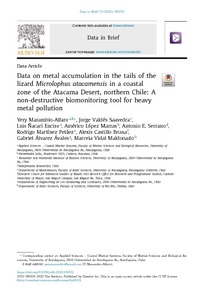Data on metal accumulation in the tails of the lizard Microlophus atacamensis in a coastal zone of the Atacama Desert, northern Chile: a non-destructive biomonitoring tool for heavy metal pollution
Autor
Marambio-Alfaro, Yery
Valdés-Saavedra, Jorge
Ñacari-Enciso, Luis
López-Marras, Américo
Serrano, Antonio
Martínez-Peláez, Rodrigo
Castillo-Bruna, Alexis
Álvarez-Ávalos, Gabriel
Vidal, Marcela A.
Fecha
2020Resumen
In this data article, we investigated the accumulation of heavy metals in the lizard Microlophus atacamensis, in three coastal areas of the Atacama Desert, northern Chile. We captured lizards in a non-intervened area (Parque Nacional Pan de Azucar, PAZ), an area of mining impact (Caleta Palitos, PAL) and an active industrial zone (Puerto de Caldera, CAL). Our methods included a non-lethal sampling of lizard's tails obtained by autotomy. The concentrations of lead, copper, nickel, zinc and cadmium were measured in both soil and prey and compared to those recorded in the lizards' tails. We estimated metal concentrations in the soil, in putative prey and M. atacamensis tails, using atomic absorption spectrophotometry. In order to characterize the trophic ecology of M. atacamensis and to relate it to possible differences in metal loads between sites, we included a few slaughtered animals to perform a stomach contents analysis (SCA). The software R Core Team (2019) was used to carry out all statistical tests to evaluate and analyze the data, applying a priori and a posteriori statistical tests to test the variance and mean hypotheses. Analysis of the data of the content of heavy metals in the tails, prey and soil inhabited by M. atacamensis in PAZ, PAL and CAL showed that the concentration of metals found in the tails and the range of environmental exposure to heavy metals of these animals were related. This article shows for the first time a quantification of the metal concentration on lizard tissues with a non-lethal technique in anthropically disturbed sites in the South Pacific.
Fuente
Data in Brief, 32, 106032Identificador DOI
doi.org/10.1016/j.dib.2020.106032Colecciones
La publicación tiene asociados los siguientes ficheros de licencia:


